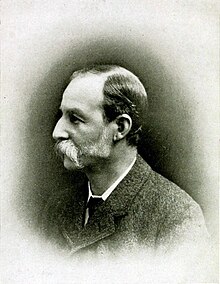Thomas Hanbury
Sir Thomas Hanbury (born June 21, 1832 in Clapham near London , † March 9, 1907 in Mortola Inferiore near Ventimiglia ) was a British merchant who was best known for his botanical garden Giardini Botanici Hanbury near Ventimiglia. He also worked as an education politician , for which he was ennobled Sir.
Live and act
Thomas Hanbury was the third son of a total of seven children by Daniel Bell Hanbury (1794-1882) and Rachel Christy. The British botanist and pharmacologist Daniel Hanbury (1825–1875) was one of his brothers. At nine he attended school in Croydon . He then continued his education in Epping , where most of the boys came from families of the Society of Friends . After graduating from school, Hanbury received instruction from a private tutor for a while. At the age of 17 he began training with a tea trading company in London's Mincing Lane .
At the age of 21, Hanbury and his cousin Thomas Christy began working for Hanbury & Company in Shanghai . For almost 20 years, from 1853 to 1872, with the exception of two stays in Europe from 1858 to 1859 and 1866 to 1868, he worked as a merchant in Shanghai. He worked for the city council and stood up for the interests of local merchants despite the difficult conditions caused by the Taiping uprising .
During his stay in Menton , France, in March 1867 , Hanbury made a trip to Cape La Mortola, just across the Italian border, where he discovered the 11th century, derelict Palazzo Orengo . Impressed by the scenic location, he acquired the palace and some of the adjacent land in May 1867. The place was to become his retirement home, around which he wanted to create a botanical garden with the support of his brother Daniel . In March 1868 he married Katherine Aldham Pease, the eldest daughter of Thomas Pease from Westbury-on-Trym near Bristol , with whom he had three children, Danny, Cecil and Horace. After returning from China, the couple spent the winter months in Palazzo Orengo and the summer months in England, the Maritime Alps and Switzerland .
On December 5, 1878, he was inducted into the Linnean Society of London . In 1889 Gustav Cronemeyer listed about 3,600 different species in his catalog of the Hanbury Botanical Garden .
Since the education system in his new adopted home Liguria was rather backward, Hanbury had a joint school built for the boys and girls in the villages of La Mortola, Ciotti and Grimaldi in 1880 . Another school for the children from the Latte valley followed in 1892. In Genoa he set up the later Botanical Institute at the University of Genoa . For the forgotten and dilapidated library of Angelico Aprosio (1607–1681), Hanbury had a new library building built in 1897, today's Biblioteca Civica Aprosiana . He also founded the Musee de Prehistoire Regionale of Menton.
After the death of George Fergusson Wilson (1822-1902) Hanbury acquired his Oakwood Experimental Garden in 1903 and the adjacent Glebe Farm in Wisley . The site, now the Royal Horticultural Society Garden, Wisley , he handed over to the trust of the Royal Horticultural Society . He donated his brother Daniel's herbarium and book collection to the Royal Pharmaceutical Society of Great Britain .
Honors
Thomas Hanbury was Commander of the Knightly Order of St. Mauritius and Lazarus and in 1888 the Order of the Crown of Italy . In 1901 he was knighted as Knight Commander of the Royal Victorian Order and was allowed to bear the title of Sir .
Joseph Dalton Hooker dedicated the 119th volume of the Botanical Magazine to him in 1893 . Several plant species are named after Thomas Hanbury, including today as synonyms guided Aloe TYPES Aloe hanburiana Naudin (1875) and Aloe hanburyi Borzi (1903).
In Shanghai, Hanbury Road and Kungping Road are named after Thomas Hanbury.
literature
- General
- Alasdair Moore: La Mortola: In the Footsteps of Thomas Hanbury . Cadogan Guides, 2004, ISBN 1-86011-140-8 .
- Maura Muratorio, Grace Kiernan: Thomas Hanbury e il suo giardino . Bacchetta, Albenga 1992.
- Lucio Russo: A mission in life: Thomas Hanbury and his garden at La Mortola, Italy . In: Bradleya . Volume 19, 2001, pp. 67-74.
- Letters
- [Katherine Aldham Pease Hanbury (Ed.)]: Letters of Sir Thomas Hanbury . London 1913 (online) .
- Obituaries
- [Anonymous]: Sir Thomas Hanbury, KCVO In: Bulletin of Miscellaneous Information . London 1907, pp. 132-136, (online) .
- [Anonymous]: Sir Thomas Hanbury, KCVO In: The Gardeners' Chronicle: A weekly illustrated journal of horticulture and allied subjects . 3rd episode, Volume 41, Number 1055, March 16, 1907, p. 172, (online) .
- George King: Sir Thomas Hanbury, KCVO In: Proceedings of the Linnean Society of London . Volume 119, number 1, pp. 46-48, doi: 10.1111 / j.1095-8312.1907.tb00009.x .
Individual evidence
- ↑ https://www.rhs.org.uk/Gardens/Wisley/About-Wisley/History
- ↑ Botanical Magazine . 3rd episode, Volume 49, 1893 (online)
- ↑ Estrela Figueiredo, Gideon F. Smith: What's in a name: epithets in Aloe L. (Asphodelaceae) and what to call the next new species . In: Bradleya . Volume 28, 2010, pp. 79-102.
- ↑ The Streets of Shanghai ( Memento of the original from March 3, 2016 in the Internet Archive ) Info: The archive link was inserted automatically and has not yet been checked. Please check the original and archive link according to the instructions and then remove this notice. . (Retrieved November 18, 2011)
Web links
- An Inventory of the Hanbury-Aggs Family Papers, 1718-1914 in the Historical Library of Swarthmore College.
| personal data | |
|---|---|
| SURNAME | Hanbury, Thomas |
| BRIEF DESCRIPTION | British merchant |
| DATE OF BIRTH | June 21, 1832 |
| PLACE OF BIRTH | Clapham near London |
| DATE OF DEATH | March 9, 1907 |
| Place of death | Mortola Inferiore near Ventimiglia |

